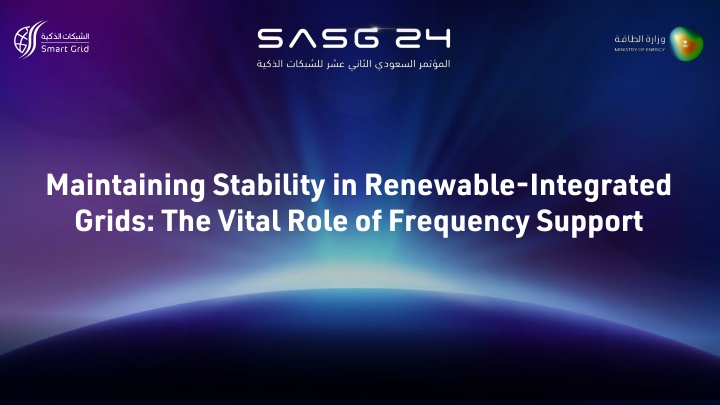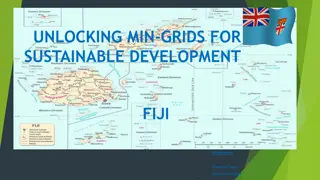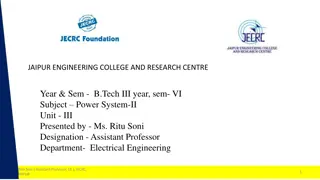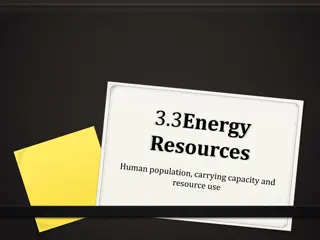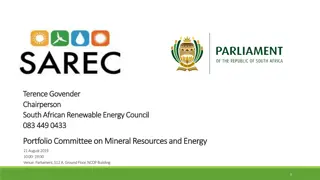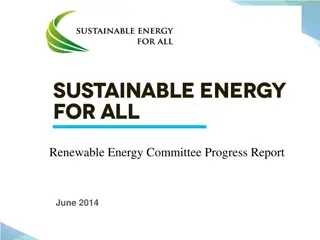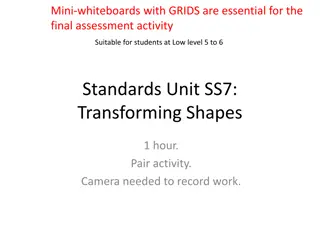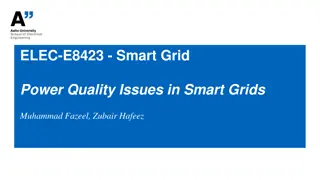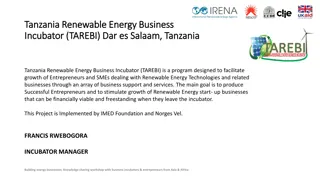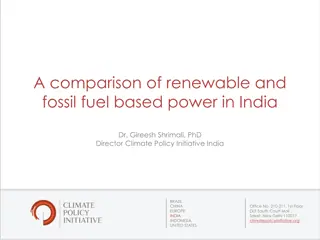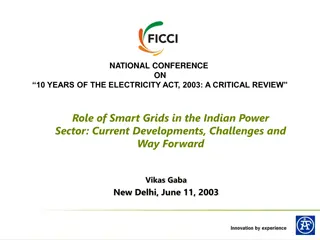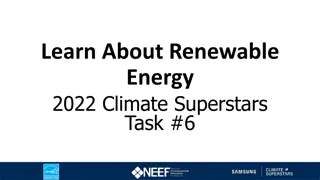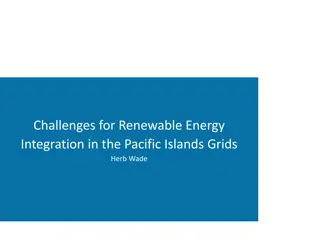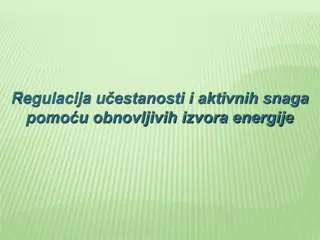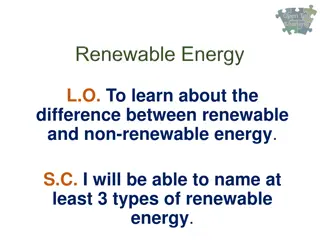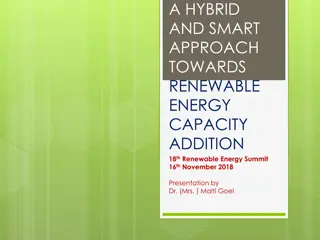Maintaining Stability in Renewable-Integrated Grids: The Vital Role of Frequency Support
The transition to renewable energy sources impacts grid stability. Learn about maintaining stability in grids with high renewable energy penetration, focusing on grid inertia, RoCoF, operating reserves, and generation dispatch.
Download Presentation

Please find below an Image/Link to download the presentation.
The content on the website is provided AS IS for your information and personal use only. It may not be sold, licensed, or shared on other websites without obtaining consent from the author.If you encounter any issues during the download, it is possible that the publisher has removed the file from their server.
You are allowed to download the files provided on this website for personal or commercial use, subject to the condition that they are used lawfully. All files are the property of their respective owners.
The content on the website is provided AS IS for your information and personal use only. It may not be sold, licensed, or shared on other websites without obtaining consent from the author.
E N D
Presentation Transcript
Maintaining Stability in Renewable-Integrated Grids: The Vital Role of Frequency Support
Outlines Introduction Objectives Frequency stability Grid Inertia Rate of change of frequency (RoCoF) Operating reserves Generation dispatch for energy and reserve Results and discussion Conclusion
1 - Introduction The transition from conventional to renewable generation is motivated by it s positive impact both environmentally and economically. The intermittency of renewable energy sources (RES) like solar and wind presents operational challenges for maintaining grid stability. Traditional thermal generation, which provides grid inertia, is being displaced leading to concerns over reduced system inertia. Renewable energy generation s excepted capacity within Saudi Arabia by the year 2027 is around 26 GW, divided between solar and wind. Frequency control becomes more complex with high RES penetration, requiring additional reserves for stabilization.
1.1 - Objectives Assess the impact of increasing renewable energy penetration on grid frequency stability. Analyze the reduction in grid inertia due to the displacement of conventional generation by RES. Identify the types and amounts of reserves required to maintain reliable system operations with high RES penetration. Evaluate the strategies for mitigating frequency disturbances through reserve optimization and system flexibility.
2 - Frequency Stability Frequency stability refers to the power system s ability to maintain a stable frequency after sudden disturbances, such as changes in generation or demand. Key factors affecting the frequency stability: Grid inertia. Rate of change of frequency (RoCoF). Operating reserves.
2.1 - Grid Inertia Power generation - Lowest demand 2023 39,000 36,592 37,000 35,000 GW 33,000 28,524 31,000 29,000 27,000 1 2 3 4 5 6 7 8 9 10 11 12 13 14 15 16 17 18 19 20 21 22 23 24 Hour KSA grid inertia - Lowest demand 2023 KSA system H - Lowest demand 2023 180.0 4.80 4.77 170.0 MWs / MVA 4.75 160.0 GW.sec 4.65 4.70 150.0 140.0 4.65 130.0 132.6 4.60 120.0 1 2 3 4 5 6 7 8 9 10 11 12 13 14 15 16 17 18 19 20 21 22 23 24 Hour 1 2 3 4 5 6 7 8 9 10 11 12 13 14 15 16 17 18 19 20 21 22 23 24 Hour
2.2 - Rate of Change of Frequency (RoCoF) Power generation - Lowest demand 2023 39,000 36,592 37,000 35,000 GW 33,000 28,524 31,000 29,000 27,000 1 2 3 4 5 6 7 8 9 10 11 12 13 14 15 16 17 18 19 20 21 22 23 24 Hour RoCoF - Lowest demand 2023 ( estimated power loss of 700MW ) 0.17 0.16 0.15 HZ/Sec 0.16 0.14 0.12 0.13 0.12 0.11 0.10 1 2 3 4 5 6 7 8 9 10 11 12 13 14 15 16 17 18 19 20 21 22 23 24 Hour
2.3 - Operating Reserves Regulation reserve Following reserve Contingency reserve Ramping reserve
3 - Generation Dispatch for Energy and Reserve Generation dispatch mix Renewable available conventional generation, limiting the reserves that can respond to frequency disturbances. energy integration reduces 16% The must-take energy (e.g., from Combined Heat and Power) and security constrained unit commitment further constrains the flexibility in dispatch, especially periods 22% 62% during low-demand Must-Take (MT) Economic Dispatch (ED) Security Constrained Unit Commitment (SUC)
3 - Generation Dispatch for Energy and Reserve Co-optimization of energy and reserves is essential to ensure that both demand and grid stability requirements are met. Fast-ramping reserves will become increasingly important as renewable generation ramps up and down, especially during early morning and late afternoon. Net demand - Typical Winter Day MW 50,000 41,781 39,656 45,000 Net Demand 40,000 35,000 30,000 25,000 28,755 25,829 20,000 15,000 1 2 3 4 5 6 7 8 9 10 11 12 13 14 15 16 17 18 19 20 21 22 23 24 Hour 2023 2024 2025 2026 2027
4 - Results and Discussion Expected KSA Grid Inertia 160 149 143 Grid Inertia reduces over the years as RES penetration increases in the network. 134 140 116 120 119 Without the addition of solutions, such as battery energy storage systems (BESS), synchronous condensers (SC), etc. The excepted grid inertia by the year 2027 of the system will decline by more than 40% of it s current value. 115 100 107 82 GW.sec 93 80 60 66 40 Assuming only SC is used to maintain current frequency inertial support, around 53 GW.sec excepted to be required by the year 2027. 20 0 2023 2024 2025 Year 2026 2027 System H-5sec System H-4sec
4 - Results and Discussion KSA Grid RoCoF (estimated Ploss-700 MW) 0.350 0.318 RoCoF increases over the years as RES penetration increases in the network. 0.300 0.226 0.250 Without the addition of solutions such as battery energy storage systems (BESS), synchronous condensers, etc. RoCoF by the year 2027 is excepted to increase by around of 80% of its current value. 0.255 0.196 0.183 0.176 0.200 Hz/sec 0.181 0.150 0.157 0.146 0.141 0.100 0.050 Considering only BESS is used to maintain current RoCoF value, around 312 MW is expected to be required by the year 2027. 0.000 2023 2024 2025 Year 2026 2027 System H-5sec System H-4sec Year 2024 2025 2026 2027 Total expected required BESS capacity (MW) 25 72 154 312
4 - Results and Discussion Year 2024 2025 2026 2027 2,095 1,317 3,296 2,937 4,332 4,333 6,529 7,297 7:00 AM 8:00 AM Fast ramp solutions include hydro- pumped storage or BESS are excepted to be required in the early morning and afternoon hours coinciding with the daily solar PV production. 8:00 AM 9:00 AM Excepted total required BESS for Ramp Down (MW) 3,412 6,233 8,665 13,826 Considering the availability of only BESS, the amount of 3-hour BESS required by 2027 may exceed 7 GW with around 15 GWh total storage. Year 2024 2025 2026 2027 1,672 1,231 2,777 2,868 3,730 4,280 5,751 7,275 4:00 PM 5:00 PM 5:00 PM 6:00 PM Excepted total required BESS for Ramp Up (MW) 2,903 5,645 8,010 13,026
5 - Conclusion The integration of renewable energy sources (RES) is essential for achieving sustainable energy goals, but presents significant challenges for maintaining grid stability, especially in terms of frequency control. As grid inertia declines with the increasing penetration of RES, the Rate of Change of Frequency (RoCoF) will continue to rise, making the system more vulnerable to frequency deviations. Solutions such as Battery Energy Storage Systems (BESS) and synchronous condensers are critical to mitigate the impacts of reduced inertia and ensure the system s ability to stabilize frequency after disturbances. To ensure reliable system operations under high RES penetration, optimization of reserves and the integration of fast-acting technologies like BESS must be prioritized.
Thank you Abdulmalik Abdulaziz Alghamdi AAGHAMDI55@NGRID.SA +966545166540
